THE COAT OF ARMS MARRES
OF THE MARRES FAMILY
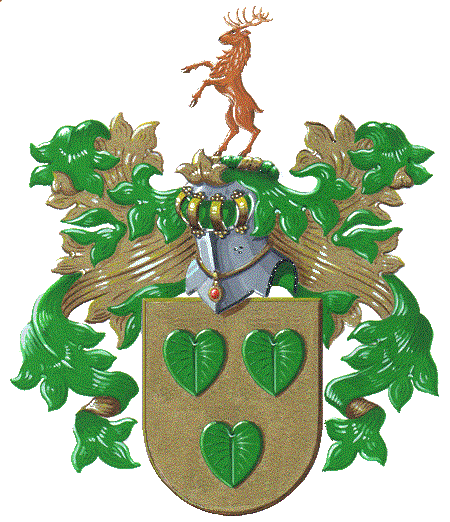
THE COAT OF ARMS MARRES
|
Recent litteratureNederlands 'Wapenboek, 's-Gravenhage, 1998. This has a detailed description of origin and history. Nederlands Patriciaat, 1961, 47 ann.; 1992, 76 ann. Limburgse Families en hun wapens, F. Goole en P. Severijns, Hasselt-Tongeren 1973. Herin is a partial description without mentioning of crests and mantling. Genealogische en Heraldische Gedenkwaardigheden in de kerken der provincie Limburg en Belgische en Duitse grensgebieden, Dr. J. Belonje, Maastricht 1961. |
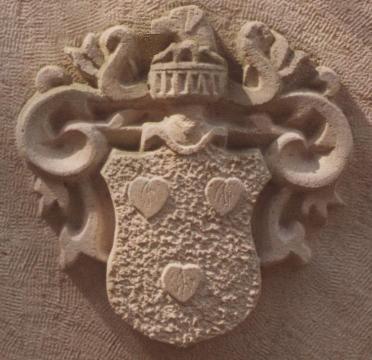
Tombstone of Louis Marres 1922-1979. |
Old ArmorialsDictionnaire des figures héraldiques, Th. de Renesse, seven parts, Brussels 1894-1903, our arms are described under the name de Marets. Armorial Général, J.B. Rietstap, Gouda, 1887. Collection des Tombes et Epithaphes dans le Pays de Hesbaye, L. de Herckenrode, Gand, 1845. Recueil Héraldique des Bourguemestres de Liège, , J.P. Gramme, Liège, 1720 Le Miroir des Nobles de Hasbaye, Jacques de Hemricourt, manuscript, 1398. The Marres family is recorded, but a description of arms is not given. |
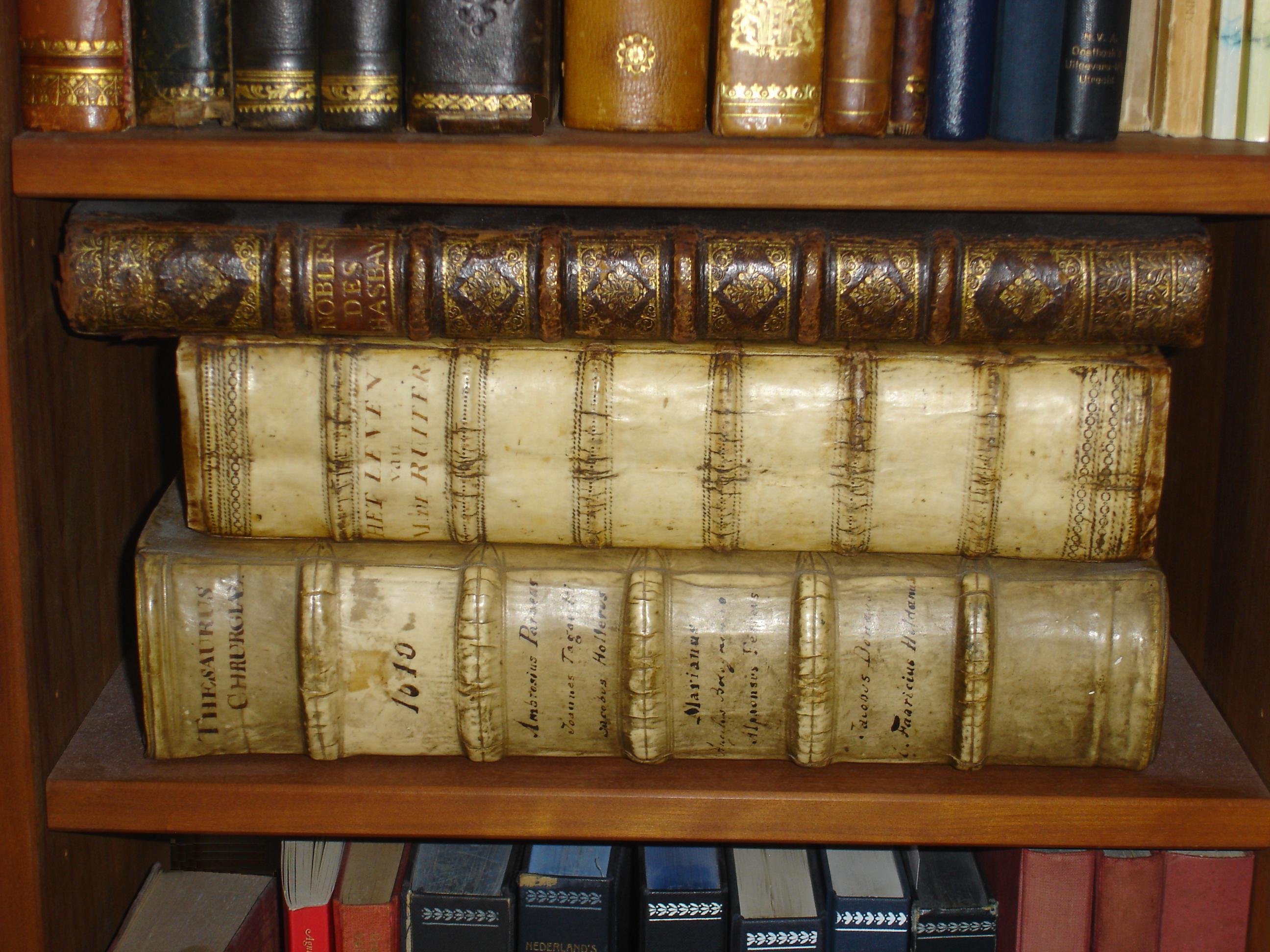 |
|
* Wax sealsIn the branch Marres four old wax stamps with weapon print are known. Each seal shows a different image. They come from three different family members, one man who used two different seals and two women who used the seal of their spouses. |
|
Seals and arms of Pau (de) Marres Pau de Marres, lived in Maastricht from 1629 until 1707 and was notary and attorney. He was the son of Paulus Matthias Marres and Maayken Smeets and the brother of Servaes Marres, beer brewer in brewery De Wildeman in de Brusselsestraat in Maastricht, who is the ancestor of the Dutch and Belgian families Marres. In his oldest seal from 1669 we see his arms: party per pale: dexter a tree, sinister a griffin rampant. Crest: a demi griffin.
In this seal points the tree in the dexter side obvious to his wife Margaretha Booms (English: tree).
|
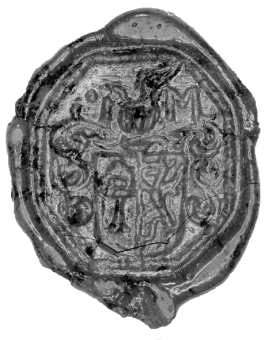
Seal of Pau de Marres |
|
The younger seal dates from 1701 and is on a letter of the Pau Marres in its function of attorney addressed to the aldermen of the county of Geleen and is preserved in their archives. Arms: Three braided together emptied more leaves. Crest: not recognizable by damage. (52) In this seal we see the more leaves for the first time, braided together and emptied. In the weapon on his tombstone he has three marsh leaves tied together. |
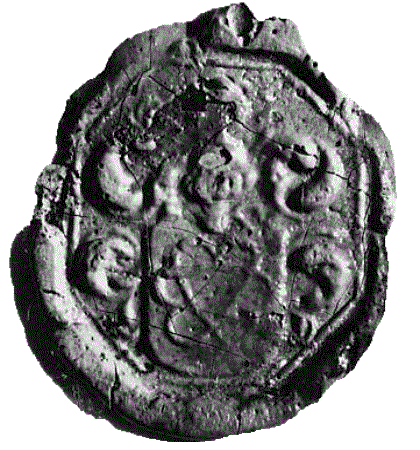
Seal of Pau de Marres |
The seals of the two Elisabeth's (de) Marres |
|
|
Elisabeth van Leeuwen - Marres, 1672 - 1710, daughter of Pau de Marres and Maria Gehlen, was married with the son of the mayor of the city Venlo in lower Gelre, Johannes Franciscus baron van Leeuwen, general in the Austrian army, commander of the field army in Italy and finally fortress commander of Mantova (Mantua). She always used the seal of her husband. When and where she died is unclear. On 8 Jan 1710 she received in Ingolstadt (Germany) her last child. This son, Engelhard August Baron von Leeuwen will be as his father Major-General and in 1766 a member of the general staff of Austria, Elisabeth probably died in childbirth or shortly thereafter. The first child of the second wife of Frans van Leeuwen, Francesca Sidonia came around 1730 in the monastery Carmellini to Mantova and will have been then eighteen years old. (53) Arms van Leeuwen: silver, a chevron red charged with three escallops gold. Mantling: red and silver. Crest: an emerging lion turned to the right black , tongue and claws red between two tulips red. |
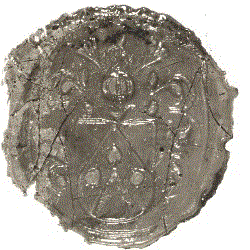
Seal of Elisabeth |
|
Elisabeth a Busco - Marres, 1696 - 1765, is a daughter of Matthijs Marres and Margaritha Lenarts and a granddaughter of Pau (de) Marres. se also seals with her husbands seal. In 1724 she married Roger a Busco. He is an officer in the States service in the regiment of General Idsinga and dies young when sill as cornet around 1733. They were living in' s-Hertogenbosch. Roger a Busco belonged to an ancient noble family of the county Loon. He was a member of the branch of the branch van de Bosch van Mopertingen, whose members are wrote their names and were called a Busco. He is born in Tongeren (Belgium) on 27 September 1702 and was the son of Arnold a Busco and Beatrix Matthijssens. The seal of Elisabeth a Busco-Marres is attached to her will of 1760. (54) Arms van den Bosch van Mopertingen: Vair and on the second row a barrulet gold charged with three lilies black. Crest: a lily. See: genealogie van den Bosch |
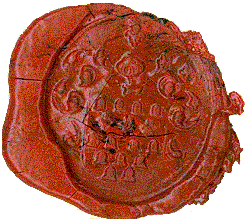
Seal of Elisabeth |
|
In the Heraldic database of the Central Bureau for Genealogy in The Hague is the weapon in this seal mistakenly interpreted as a weapon Marres, but it is a weapon of the family of the Bosch alias a Busco Branch Mopertingen. (55) .jpg)
Seal and signature of Elisabeth a Busco-Marres, 1760 * |
De Oude tombstone Marres |
|
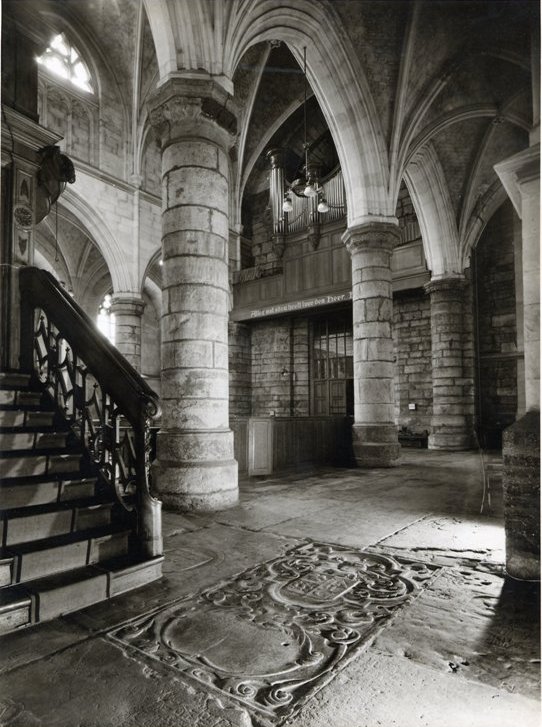
|
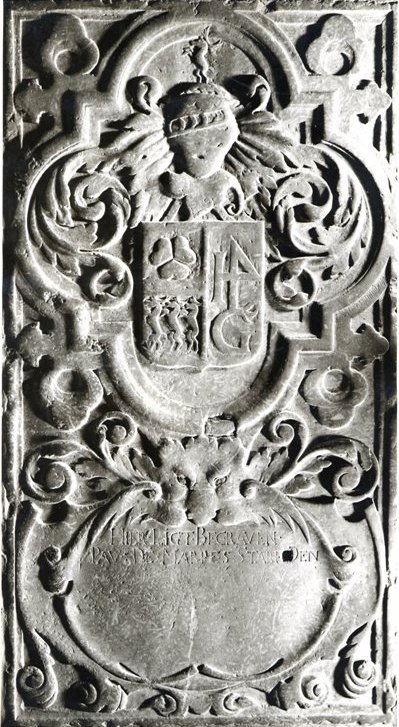
|
|
Interior St Janskerk. |
Tomb Pau de Marres |
|
In the St. John's (Sint Jan) Church of Maastricht, before the pulpit lies the beautiful carved and well preserved tombstone of the above already mentioned Pau Marres. This tombstone has over the years but little worn. Pau is born as 'Palmachius', but he shortens his first name to 'Pau' and places the prefix 'de' before his surname. He is notary and attorney in Maastricht and becomes in the French time (1672-1678) alderman of Valkenburg. He is also alderman of Tweebergen and mayor of the court of aldermen of Sint Pieter in Montenaken, He dies in 1707 and is buried in the church of the Monastery of the Crosiers at Maastricht where his son William Marres became in 1711 procurator and in 1721 prior. The tombstone has was the French time located in the convent of Preachers. Then the French expropriated and dismantled the monasteries of Maastricht and sold the buildings. The tombstone was saved by transfer to St. John's Church, where he is still to admire at the foot of the pulpit. St John's Church came into Protestant hands when Maastricht was annexed in 1815 by the Netherlands, fortunately the tombstone was spared. On the stone is carved his alliance weapon in a cartouche. The shield is party per pale and dexter party per fess. In the first quarter are three adjacent placed marsh leaves, in the second quarter is the weapon of his first wife Margaret Booms and in the left half of the weapon is the brand of his second wife Maria Gehlen. The crest is a climbing deer. Below we see a lion and in his open mouth the text: Here lies buried the late Pau Marres died the ... . The lack of further text is clearly not the result of wear and tear but is not completed after the funeral. There can only be guessed at the reason, though there are suspicions. Pau beared in het arms three marsh leaves, but was experimenting with the placement. In his seal of 1701 the trio is emptied and knit together, here they are placed adjacent, the points to the middle. Matthijs Marres, the son of Pau de Marres, was mayor of the seigneuries Genk and Zutendael, and his son Jan Marres was his successor. Jan Marres is also chosen in the period 1747 to 1746 as mayor of the city Tongeren. He married the widow of the founder of the Dutch and Belgian noble family de Bellefroid, but his marriage was childless. Strange is that his seal is not found. |
|
In the same church stands against the north wall is the memorial of Margarita Elizabeth Cabeliau-the Grijse, It is a large and beautifully sculptured tomb with lions and an underlying skeleton. This contains her sixteen quarter weapons, including a weapon similar to ours and below this is chiseled the name Marre. However this is, unlike the name suggests, the blazon of the family van der Meer from Delft. The waterlily leafs are shown here with stalks. |
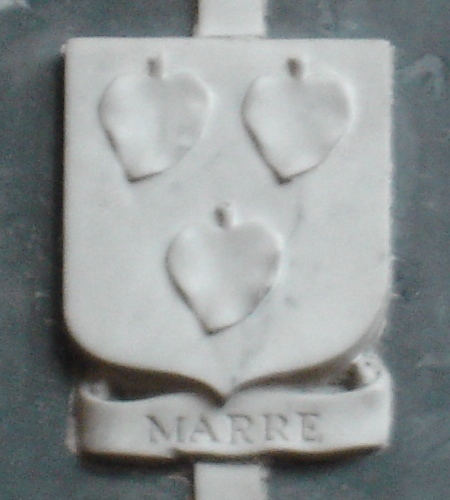
|
|
* COAT OF ARMS MARÈS IN FRANCE |
|
MARÈS(France - Nîmes) |
MARÈS(France - Cissac-Medoc) |
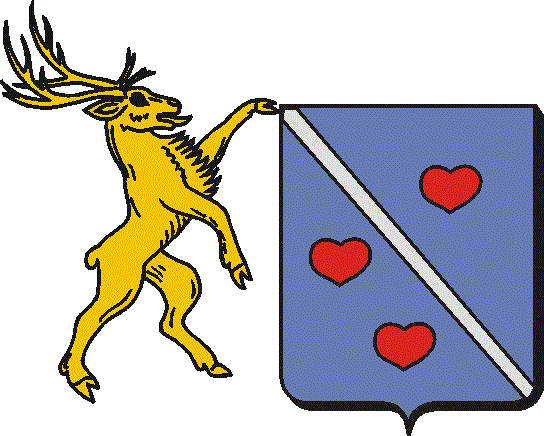
|
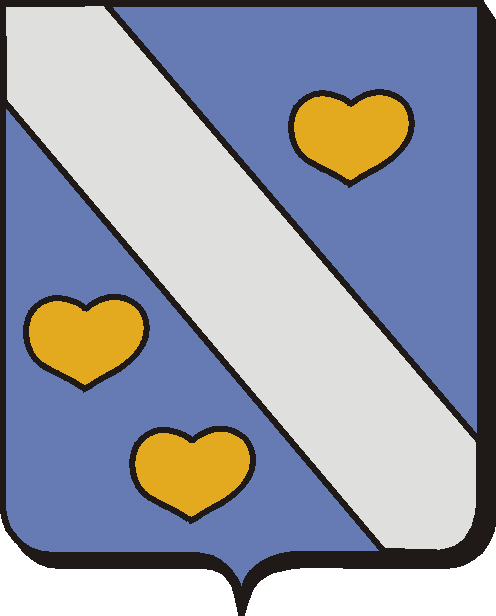
|
These are described in Arms Mares françaises. |
|
|
* An Alanian Jewel and a Banner of the TatarsTillya-tepe, Pakistan - Wolga, South Russia` |
|
|
Pau de Marres, 1629 - 1707, carried in his arms, showing his seal from 1701 three emptied, braided together, more blades. On his tombstone are these free and fork-wise placed together. A figure that is very similar to the figure in his seal, three braided together more leaves, are also in the banner of Volga Tatar warriors. Right you see the banner of the Tartars and below an image of a seal of Pau de Marres. |
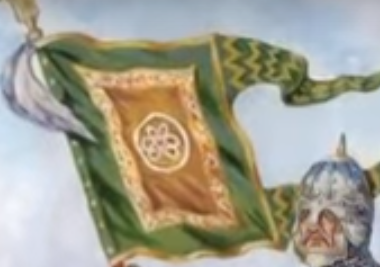
|
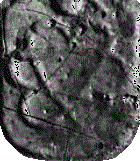
Detail Zegel Pau |
* |
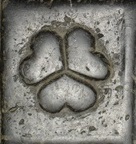
Detail Zerk Pau |
* |
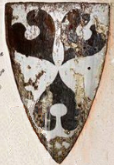
Schild Nordeck |
|
The adjacent, trefoiled, placement, the tops of the leaves pointing to the center, we find also in the first quarter of his shield on his tombstone. In Germany, this figure is found more often. Heraldic (G.): Dreipaßförmig mit den Spitzen zusammengestellten, rund ausgeschlagenen schwarzen Seeblättern in silbernem Feld. The old families von Cleen, von Derbach and Nordeck zu Rabenau. Of the latter is known an image from the thirteenth century. Later it developed into a cloverleaf. |
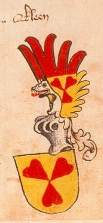
|
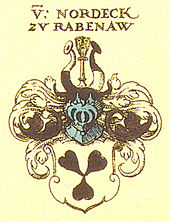
|
|
This treasure is found in the mound of a nomadic prince and his five wives, it is dated around the middle of the first century of our era. Three of the women wore Sarmato-Alanian jewelry, including that depicted here that is in the British Museum in London. The pattern of a heart motif is common in the graves of Tillya Tepe in Pakistan, it is frequently found in each grave. It is always turquoise. Elsewere this motif is rare in antiquity. It's probably not a heart but a leaf, an ivy leaf. On the handle of a richly decorated knife the leafs had stalks. |
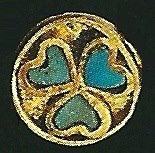
Alanic Jewel |
|
* COAT OF ARMS MARES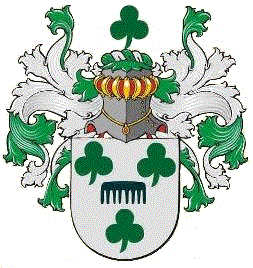
Shield: silver, a black comb accompanied by three clover leaves green.
|
|
This weapon is on the wax seal of a letter from Michael Mares, 1727-1818, son of Peter Mares, brewer to Wolder and Helena Jorissen. The letter is addressed to the States General in The Hague and dated 5 February 1762. In it, he makes a request to be favored with the prebend of the cathedral chapter of St. Servatius in Maastricht by the death of Baron de Mean released. (60) The comb in the shield may indicate the guild of the cloth shearers wherein members of this family in the Middle Ages were active. Michael Mares, who is a priest in the Vroenhof Maastricht, does not obtain the function because his bid is outbid by PLJ van der Vrecken. Later he is vicar of the noble convent Vylig and Dietkirchen in Bonn (Germany). To the church of Wolder he donated a silver chalice. (61) |
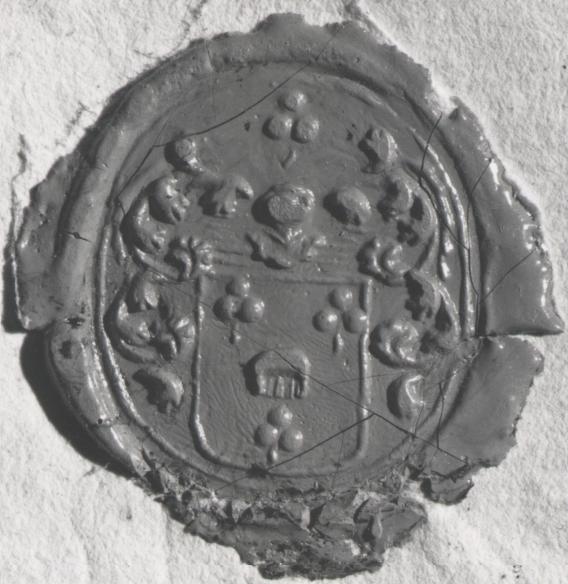
Seal van Michaël Mares |
|
The stamp with which the letter was sealed was found by metal detection in Belgian Lanaken in 2016. The wooden handle was not preserved. Description: Material: copper ?; size: about 30mm height (handle), the actual stamp is 20 mm x 18 mm, Mass (weight): 7.99 gr. (62) |
|
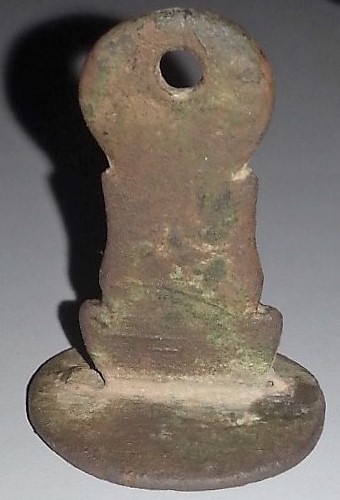
|
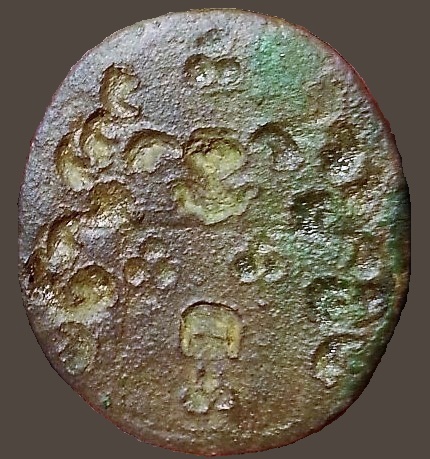
|
|
Seal stamp Michael Mares, 18th century |
|
|
|
|